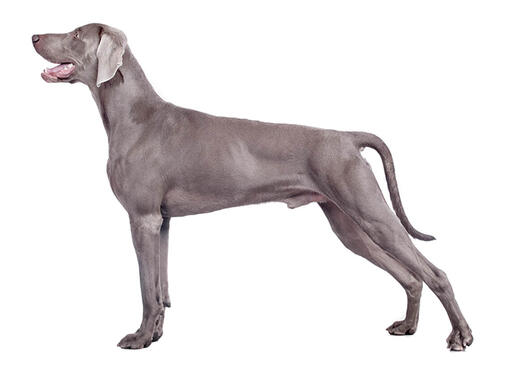
A graceful and aristocratic German breed the Weimaraner was developed for speed, scent ability, courage, and intelligence. Originally used to hunt wolves, deer and bears, the breed adapted to become a bird dog and hunting companion as large game became less prevalent. Friendly, fearless and alert, the Weimaraner loves children and enjoys being part of a family. He is obedient and easily trained, and his short coat requires a little maintenance.
DID YOU KNOW? Brad Pitt has a Weimaraner named “Purty.”
ALSO KNOWN AS: Weimaraner Vorstehhund
The need-to-know
- Dog suitable for experienced owners
- Some training required
- Enjoys vigorous walks
- Enjoys walking one to two hours a day
- Large dog
- Minimum drool
- Requires grooming once a week
- Non hypoallergenic breed
- Quiet dog
- Guard dog. Barks, alerts and it's physically protective
- May require training to live with other pets
- May require training to live with kids
Personality

Weimaraners are all-round dogs who love family life. They are friendly and energetic but, with their vigilance, make excellent guard dogs. They are very strong characters so are not the ideal first dog for a novice owner, but if you have experience and can socialise, train and exercise them, they make a very rewarding companion.
History and Origins

Country of Origin: Germany
Known as the Grey Ghost, the Weimaraner’s origins spring form the court of the Grand Duke Karl August of Weimar sometime around 1810. His aim was to breed a perfect hunting dog and so crossed German Pointers, French Hounds and Bloodhounds to produce a dog that would be as happy hunting bears as they would be birds. He also wanted a head-turning dog that would be a status symbol for the nobility.The breed was closely guarded in Germany, until just before the outbreak of the second world war, when a breeder managed to acquire a male and two females and take them to the US. In 1943, the AKC recognised the breed but it wasn’t until the 1950s that they made their way to the UK.
Nutrition and Feeding

Large breed dogs, as well as having large appetites, benefit from a different balance of nutrients including minerals and vitamins compared to smaller-breed dogs. Weimaraners are prone to bloating and stomach problems; smaller, more frequent meals can help minimise this risk.
Exercise

Weimaraner is an energetic, highly active dog that needs plenty of dog exercise to keep him healthy and happy. Without it, he can become destructive, boisterous, or an escape artist! Many enjoy swimming, and love to retrieve and both these activities keep their active minds occupied. An adult Weimaraner needs two-plus hours of regular daily exercise along with ongoing training.
Ideal Owner

Weimaraners would suit an active rural owner who enjoys a lot of exercise and will spend time training and socialising their dog to bring out the best in them.
Other Information

Health and common issues
As with many breeds, the Weimeraner dog breed can suffer from hip dysplasia (a condition that can lead to mobility problems) and hip scoring of dogs prior to breeding is therefore important. As with many large breeds they are also more prone to some bone conditions, heart disease and a specific stomach condition (gastric dilation volvulus).
Space requirements
This is a large dog who needs a good-sized, well-fenced garden and a country location to ensure he gets all the exercise he needs.
Training weimaraners
The Weimaraner can be a challenge to train as he is often stubborn and strong willed, and he needs an experienced owner to get the best out of him. Once convinced to work, the Weimaraner loves to be challenged by training – and for many, agility is an ideal answer. Early and ongoing socialisation is important with this breed.
Best family dog breeds
The Weimeraner is a friendly dog but often too bouncy and active to live with young children. In a family with older, quitter children, he can make a great family dog. While many dogs are traditionally thought of as being good with children, all dogs and children need to be taught to get on with and respect each other, and be safe together. Even so, dogs and young children should never be left alone together and adults should supervise all interactions between them.
Did you know?
- The Weimaraner got its name from the Grand Duke Karl August of Weimar, whose court enjoyed hunting and is credited for founding the breed.
- Often known as the Silver Ghost, the Weimaraner has, in his past, been used for a variety of hunting tasks and became an all-around gundog, although he was originally bred as a pointer. It is said that when hunting, this dog’s instinctive hunting method is to attack the prey’s genitals to bring it down. Interestingly the same instinct is seen in hyenas.
- The Weimeraner has found fame thanks to American photographer William Wegman, who features the breed extensively in his (sometimes rather bizarre) pictures of his dogs often dressed in human’s clothes.